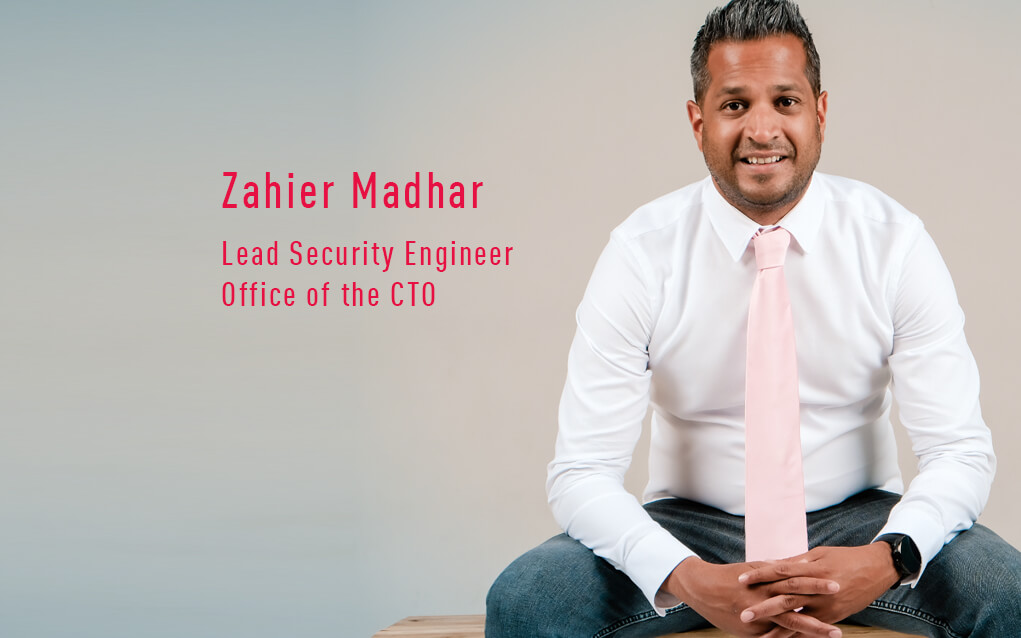Text embeddings are vector representations of words, sentences, paragraphs or documents that capture their semantic meaning. They serve as a core building block in many natural language processing (NLP) applications today, including information retrieval, question answering, semantic search and more. Recent advances in large language models…
How small businesses can mitigate the dark side of digitization – CyberTalk

I’m Zahier Madhar, and I’m honored to work as a Lead Security Engineer and Check Point Evangelist. I’ve been part of the Check Point team since 2012, and my journey in the industry began in 2006. I’m dedicated to helping Dutch companies boost their cyber security. Outside of work, I enjoy practicing Krav Maga, going for runs, and staying updated on cyber threats using Check Point’s research (https://research.checkpoint.com), Telegram, and various forums.
In this brilliant interview, Check Point expert Zahier Madhar offers astute and thoughtful insights into the state of digital transformation for non-traditionally digital businesses. Discover ultramodern trends, original thinking, and actionable security strategies. Don’t miss this!
Can you share a bit about the trends that you’re seeing in terms of every business becoming a digitized business?
Companies are digitizing more than ever before. The digitization has been driven by a variety of reasons, such as reducing costs, reaching a larger audience, and enhancing customer experience, among others. This trend is not limited to large enterprises, but extends to businesses like the bakery next door. In the modern world, even the local bakery is embracing digitization. The reasons behind these transformations are often similar to those of larger companies.
For instance, many bakeries are incorporating smart or connected ovens. These ovens allow bakers to upload or program baking processes, making the baking process more efficient and dynamic. Additionally, numerous bakeries have adopted webshops, enabling customers to order bread online for convenient pickup, resulting in a direct increase in sales. E-commerce plays a crucial role in attracting more customers to both the physical shop and the online platform.
To streamline operations, the Point of Sale (POS) system is connected to the internet. This reduces administrative tasks. This integration enables the bakery to focus on what they do best — baking bread. Like any other business, the bakery is constantly seeking opportunities to enhance efficiency, increase customer satisfaction, and reach a wider audience, ensuring that the process of digitization never comes to a halt.
A big step in going digital is using cloud technology. This allows businesses, including bakeries, to become more flexible and scale their resources based on demand. Cloud technology enables the bakery to host its website, webshop, and POS system efficiently.
Another noteworthy step in digitalization is the use of Artificial Intelligence (AI). AI is widely employed for data analysis, predictive analytics, and personalized customer experiences.
Even a bakery can explore using AI for digital transformation. For instance, by analyzing purchasing history, AI can customize marketing campaigns and implement dynamic pricing based on demand and time of the day.
Finally, the Internet of Things (IoT) is a key component of many companies. Organizations are incorporating smart screens, camera systems, and climate control to enhance convenience for employees and to save on costs. Continuing the analogy above, the bakery is leveraging IoT in its digital transformation journey. From smart ovens to temperature monitoring and energy management, IoT applications enable the bakery to operate more efficiently, receive alerts during the baking process, and achieve cost savings.
Can you provide an overview of the positive and negative aspects of this trend, especially as they relate to cyber security professionals?
Security is the most important concern in digital transformation. Digitizing requires adopting a robust cyber security strategy, enabling the business to undergo transformation in the most secure way. The digitalization of the business introduces various technologies such as cloud, SaaS, IoT, and AI, allowing employees to work from any place at any time.
In the example for the bakery, it means that the baker can monitor the baking of the bread while he is working in the shop serving customers. This flexibility is a significant advantage for business continuity. However, it also makes things challenging for security experts.
The process of digitization blurs the borders between secure and unsecured networks, increasing the attack vector as more technologies are connected to the internet. More connections mean a higher chance of data breaches. So, it’s important for security experts to be there from the start and to stay involved as digitization keeps going.
| Pro | Con |
| Flexible | Security |
| Efficiency | Maintenance |
| Improve customer experience | Knowledge |
| Innovation | Complexity |
| Expand market reach | Compliance |
| Improve communication | Data privacy |
| Marketing | Trust |
| Digital payments | Integration |
| Scalable | Monitoring |
Given the above, what specific challenges do you foresee for non-traditionally digital businesses in terms of data security?
It is essential for everyone to have a basic cyber security awareness knowledge, similar to understanding the importance of locking the door when leaving the house or wearing a seatbelt while driving. This awareness is crucial in recognizing phishing emails, avoiding malicious links, and refraining from opening unknown files from unfamiliar storage devices.
However, implementing the correct security strategy to support the digitization of a non-traditionally digital business requires the expertise of a security professional. Employees also need to undergo awareness training on how to handle data securely. Having a security professional and doing training usually costs money, and limited budgets might make it a challenge.
Also, there are other things to think about that require a security professional, like keeping data private, watching for security issues, and doing routine maintenance. These additional aspects are important for keeping a safe digital space and need careful attention.
To summarize, the challenges would be budget, the right technology, knowledge and awareness.
Do you think it’s realistic for our world to effectively demand that every business owner and operator become a digital and cyber expert?
No, I don’t think so. It isn’t realistic to expect every business owner and operator to become a digital expert. What I believe is realistic is that every business owner and operator has basic knowledge, such as using strong passwords (MFA), being aware of phishing attempts, and ensuring that software is kept up-to-date. I also think it’s practical for business owners to be security champions, making sure that steps taken for digitizing the business are done securely.
For businesses like bakeries, or [insert a similar example], what strategies do you think are effective in maintaining simplicity and sufficient cyber security?
A basic plan doesn’t need to be complicated. There are a few effective items that can be taken care of even by non-security professionals:
1. Ensure that employees have basic knowledge like not sharing passwords, using strong passwords, and recognizing phishing attacks.
2. Keep all devices up-to-date with the latest software updates.
3. Separate the guest Wi-Fi from the work network to enhance security.
4. Schedule regular scans with the endpoint security client to ensure no threats are overlooked.
5. Maintain a list of all hardware and software products, along with their versions.
A good next step would be to enhance the security architecture to prevent more complex and advanced threats targeting the broad attack surface introduced by digitization. Check Point provides a unified architecture focused on preventing threats across various attack surfaces. Additionally, the architecture introduces a standardized cyber security language to create a security policy that enables any type of company to conduct their business securely over the internet.
A strong follow-up to this is creating an incident response plan. For instance, ensure you have contact details for an incident response team that you can reach in case of an incident. If you don’t have one, take note of the Check Point incident response team at +1-866-923-0907 (https://www.checkpoint.com/support-services/threatcloud-incident-response). Understand the impact on the bakery and inform the employees promptly.
How else can the risks associated with the ‘dark side of digitization’ be mitigated?
I highly recommend that every type of business embrace digitization to maximize efficiency. Security should always be an integral part of the overall strategy.
For large enterprises, I strongly advise implementing a security strategy that comprehensively covers all attack vectors. This can be achieved through a consolidated platform, which lowers the risk of misconfigurations, provides better visibility, and simplifies security tasks. The platform should be API-driven to facilitate automation and integration with third-party solutions.
Remarkably, enterprise-grade security and technology are now accessible even for smaller businesses, such as the bakery next door. Check Point offers solutions tailored for small to medium-sized businesses, allowing them to leverage the right technology to address the diverse attack vectors associated with digitization. The Check Point solution provides a consolidated architecture that is easy to set up and maintain, even for those without extensive security expertise. It secures networks, mobile devices, endpoints, cloud email, and SaaS apps.
In summary, my strong recommendation stands: Every business, regardless of size, should embrace digitization to enhance efficiency, with security integrated into the core of their strategy. More information about the available solutions for small and medium businesses can be found here: https://www.checkpoint.com/solutions/small-medium-business-security.
Based on your observations and analyses, what are the key takeaways for CISOs and cyber security professionals here?
Digitization sounds appealing and is currently a trend. It is tangible, making many business owners proud as they modernize their processes. However, when something goes wrong, the impact can be significant — customer data might leak, passwords might be stolen, or smart IoT devices could become part of a botnet.
The world is more digital than ever, and there’s no reason to believe this trend will stop. Digitization requires cyber security involvement at every step, from regulations to technical details.
1. Digitization adds value to any business.
2. However, the dark side is that it increases the attack surface.
3. The role of a Chief Information Security Officer (CISO) is crucial to realizing a secure and future-proof transformation.
Is there anything else that you wish to share with the Cyber Talk security community?
The key to successful digitization is integrating cyber security; from regulations to technical details. This ensures that the transformation is future-proof and secure, making it easier to adopt new regulations like NIS2 and expand the range of products connected to the internet while mitigating potential risks.
Michael John Gorman named MIT Museum director

MIT has appointed Michael John Gorman the Mark R. Epstein (Class of 1963) Director of the recently re-imagined MIT Museum.
Gorman replaces longtime museum director John Durant, who stepped down in 2023. Originally from Ireland, Gorman is the founding director of BIOTOPIA – Naturkundemuseum Bayern in Munich, Germany, a newly established innovative center and museum space for life sciences and environment. Since 2015, he has been responsible for the development of the center’s vision, exhibition strategy, and operations and festivals combining science and the arts. He is also a tenured university professor for life sciences in society at the Ludwig Maximilians University in Munich.
Gorman was the founding director of Science Gallery at Trinity College, Dublin, Ireland, a groundbreaking public space for innovation, science, and the arts. From 2012 to 2016, Gorman served as CEO of Science Gallery International, a nonprofit he founded with university partners to support the establishment of the Global Science Gallery Network in cities including London; Melbourne, Australia; and Bengaluru, India.
From 1999 to 2000, Gorman held dual postdoctoral fellowships at MIT’s Dibner Institute and Harvard University’s Department of History of Science, before becoming a lecturer in science, technology, and society at Stanford University. He is the author of books on topics ranging from Buckminster Fuller´s designs to 17th century art and science to the recent book “Idea Colliders: The Future of Science Museums,” published by the MIT Press. He has curated numerous exhibitions and festivals bridging science, art, technology, and design around the world.
“I see the MIT Museum as a dynamic public forum, a place to encounter possible futures, and a leading center for public engagement at the nexus of science, technology, and the arts and design,” says Gorman. “I’m greatly looking forward to building on the excellent work that’s been done by the museum team since its re-opening at the spectacular new site in Kendall Square, and to realizing the museum´s vast potential as MIT’s window to the world.”
Kathryn Wysocki Gunsch, deputy director of the MIT Museum, will serve as interim director until Gorman takes up his post this summer.
In October 2022, a reinvented MIT Museum opened in a new location in the heart of the Kendall Square Gateway of MIT’s campus at 314 Main Street in Cambridge, Massachusetts. The museum aims to make innovation and research available to all by presenting the best of STEAM, and to “turn MIT inside-out,” inviting visitors to take part in ongoing research while demonstrating how science and innovation will shape the future of society.
Highlights include freshly conceived exhibitions featuring objects from the museum’s prodigious collections of over 1.5 million objects, along with loans of art and artifacts; the Lee Family Exchange event space for public dialogue and conversation; a hands-on Heide Maker Hub, where audiences can experiment with putting scientific ideas into action; and an enlarged store.
Diving into nuclear submarines

In 2021, the United States, United Kingdom, and Australia formed a partnership, dubbed AUKUS, which will allow the Royal Australian Navy to purchase several nuclear-powered submarines in an effort to modernize their fleet.
Building a nuclear submarine program from scratch is anything but easy, but when they set out to do so, the Australian navy knew exactly who to turn to for expertise. Shortly after the announcement, Australian Vice Admiral Jonathan Mead in an interview suggested sending staff to MIT.
That offhand comment eventually found its way to Jacopo Buongiorno, professor of nuclear science and engineering and director of the Center for Advanced Nuclear Energy Systems at MIT, and served as inspiration for the newest executive education course offered by the Department of Nuclear Science and Engineering (NSE).
A deep dive on nuclear programs
Titled “Nuclear Technology for Marine Propulsion,” the three-week course was attended by 20 senior leaders from the Australian Submarine Agency (ASA) and other officials, and covered a broad range of topics, including the basics of nuclear reactor theory and design, operations and safety, training, the operation of nuclear shipyards, and more.
“NSE is truly excited for the opportunity to help the Australian navy as they navigate the establishment of their nuclear program,” says Benoit Forget, NSE department head and Korea Electric Power Professor of Nuclear Engineering, who co-directed the course. “Understanding the technology and establishing foundational safety principles is essential to the long-term success of their project, and we were glad to see the importance they attributed to these principles by seeking our help.”
Sessions were led by MIT faculty and a variety of external subject matter experts and included special guests like MIT Vice President for Research Maria Zuber and retired U.S. Navy admirals Jim Ellis and John Richardson.
“The technical content of the course was rich,” Buongiorno says. “We started with nuclear physics, reactor physics, thermal-hydraulics, nuclear materials, fuel performance, and the nuclear fuel cycle, and then expanded into what one might call the ‘softer’ aspects of nuclear technology, such as training, oversight, safety culture, supply chain, the role of the national labs, etc.”
In fact, these aspects are not soft at all, Buongiorno explains, as they can determine whether a nuclear technology program succeeds or fails.
“This is one of the great lessons from the successful nuclear naval propulsion program in the U.S.,” he says. “It’s about the technology, the people, and the governance in equal parts.
“For example, in-depth training of people and the creation of a robust safety culture are critically important because nuclear reactors are not a particularly tolerant technology,” he continues. “Hence the need for relentless attention to detail and conservative decision-making. Therefore, we felt from the very beginning that this should not be a purely technical course.”
A long history of professional education
While it is the newest professional education course offered by NSE, the ASA course was modeled after another course, called “Reactor Technology Course for Nuclear Utility Executives,” which the department has offered for more than three decades, jointly with the Institute of Nuclear Power Operations. In both cases, Buongiorno says, the goal is to ensure participants come away with a basic understanding of nuclear technology, feel confident to ask smart questions, and make the right decisions in their respective positions.
Given the important future roles of the course participants — many were senior leaders in the Australian navy, government, and policy community — the course may end up having significant impacts, he adds.
“The Australian navy course is one more recent example of the international involvement and impact of my NSE colleagues,” Forget says. “Two additional recent examples are the Global Forum Rising Stars Workshop, in collaboration with the Nuclear Energy Agency, that brought together incredible female researchers from around the world, and the 2023 David J. Rose Lecture given by International Atomic Energy Agency (IAEA) Director General Mariano Grossi, who discussed the role of the IAEA on global nuclear safety.”
Providing such executive education, Buongiorno says, is central to MIT NSE’s mission. In addition to courses for the ASA and utility executives, the department in recent years launched a three-day course for policymakers, legislators, journalists, and others, titled Nuclear Energy: Facts and Issues, has offered a course on Nuclear Operational Risk Management for a decade, and its longest-running course, on Nuclear Plant Safety, has been offered annually since 1966.
“The mission of our department is not limited to technology development and education of our students. It includes also informing the broader community of stakeholders in the media, the government, the industry, the investment community, all the way to the general public, about the beneficial uses of nuclear science and technologies,” he says.
The Power of LiveU Remote Production: 2 Global Studios & 4 Remote Loca – Videoguys

Discover how Gradient Experience, a leading live production company, utilized LiveU technology to overcome the challenges of producing JAB Holding Company’s two-day Investor’s Conference, featuring 32 C-Level speakers from two global studios and four remote locations. In response to the need for a flexible and scalable solution, Gradient incorporated LiveU for live feeds and live-to-tape content within a cutting-edge 3D virtual world. The production, hosted on Unreal design platform and powered by Brainstorm’s 3D hardware, successfully brought CEOs from diverse locations, including LA, Boston, Chicago, New York, Amsterdam, and Edinburgh, into a London-based control room.
Key Challenges:
- Hosting a two-day global Investor’s Conference with 32 C-Level speakers.
- Ensuring a high-quality virtual experience for 200+ attendees across 30+ countries.
- Creating a workflow that accommodates the varying needs of CEO presenters worldwide.
Innovative Solution: Gradient Experience tackled these challenges by leveraging LiveU technology at the core of its production. By creating a virtual world using Unreal and Brainstorm, the company seamlessly integrated C-Level Executives into the virtual program, resulting in a successful and highly repeatable hybrid remote production model. LiveU’s adaptability allowed for last-minute scheduling changes, ensuring the event’s smooth execution.

Testimonial: Corey Protin, Head of Livestream & Studios at Gradient, highlighted the significance of LiveU: “The use of LiveU allowed our team to adapt to last-minute changes in scheduling. When a guest could no longer fly to our London green screen facility, we simply used a LiveU encoder alongside the LiveU LU4000 4K/quad HD rack-mount receiver to bring him/her into the production. We were able to meet the presenters’ needs without sacrificing our production quality.”
Results: Gradient Experience, in collaboration with LiveU, not only met but exceeded audience expectations by delivering an engaging and high-quality virtual production far beyond the traditional Zoom meeting aesthetic. The hybrid remote production model showcased its success and repeatability, featuring CEOs from renowned companies like JPMorgan Chase, Panera, and Pret-A-Manger.
Read the full story from LiveU HERE
Isabela Merced Joins The Last Of Us Season 2 As Dina

Update, 1/11/2024:
Shannon Woodward, the actress who originally portrayed Dina in The Last of Us Part 2, has responded to the live-action casting of Isabela Merced. In addition to a tweet of general support for Merced, Woodward responded to a fan who wondered why she didn’t reprise her role in the sequel. In short, it’s because of her age.
“Bcs [sic] I am… Much older lol,” Woodward’s second tweet reads. Much like Ellie’s original actress, Ashley Johnson, Woodward is about 20 years older than the character she portrays. Dina’s character model is actually based on an entirely different person, Cascina Caradonna, who fits the age range of the character. That said, Joel’s video game actor Troy Baker, along with Johnson, received a cameo role in the show, so it wouldn’t be surprising if Woodward showed up in some other way, even briefly.
The original story continues below…
This week, HBO has been on a string of cast reveals for season two of their Emmy-winning adaptation of The Last of Us. Today, the live-action roster grows even more, adding Isabela Merced as Dina.
Merced is best known for her role as Dora in the live-action feature Dora and the Lost City of Gold, but gamers might also know her as the voice of Keyblade Master Ava in Kingdom Hearts χ Back Cover. She’s also set to appear in both the Marvel and DC universes as Anya Corazon in Madame Web and Hawkgirl in Superman Legacy. In her upcoming role as Dina, we expect her to be spending a lot of time on screen with Bella Ramsey’s Ellie, but we’ll leave it at that for spoiler reasons.
This news follows the casting of Kaitlyn Dever as Abby and Young Mazino as Jesse, two other characters in the next part of Naughty Dog’s critically acclaimed sequel. While we’ve yet to see the show’s second season, it seems to be relatively faithful to the games, so we can expect these characters to carry some extreme importance in the next chapter of Ellie and Joel’s collective journey. In fact, Abby, Jesse, and Dina will all be playable in the upcoming roguelite mode included in The Last of Us Part II Remastered – check out our episode of New Gameplay Today to see the action for yourself. If you’re interested in playing the game before the new season comes out, check out our review for The Last of Us Part II here.
Switch 2 Allegedly Launches This September, According To An AI Company’s Press Release

There are few things the internet is hungrier for than news about the Switch successor. With relative silence from Nintendo, folks have been left to grasp at straws and theorize what it will look like, how it will be played, and when it will be released. Today, thanks to Digital Trends, we might have an answer to that last question, and it came from a rather odd place.
Back in the day, GameShark was known for making cheat code cartridges in video games. You could plug it into your system, download cheat codes, and use them to become the master of games on your N64, PlayStation, or Game Boy. However, in recent years, the company has decided to take a turn in the direction of the company. Renamed “AI Shark,” it’s now a software-agnostic program designed to provide “personalized hints and assistance that keep up with fast-paced, competitive gaming.” What does any of this have to do with the Switch 2? It’s all in one sentence at the end of the first paragraph of their press release.
“The official launch is planned to coincide with the Nintendo Switch 2 in September 2024.”
To be clear, Nintendo has offered no official confirmation that this is an accurate launch window, and there are myriad reasons to doubt the validity of the claim. Bloomberg‘s Jason Schreier reports that AI Shark is simply guessing at the Switch console’s release date. Regardless, it is an odd statement to make in an official press release, and it will be very interesting to see Nintendo’s response, assuming it issues one.
For more Nintendo Switch, check out our episode of All Things Nintendo where we list our most anticipated Switch games, and then read up on how Prince of Persia: The Lost Crown runs on the console.
[Source: Digital Trends]
OpenAI launches GPT Store for custom AI assistants
OpenAI has launched its new GPT Store providing users with access to custom AI assistants. Since the announcement of custom ‘GPTs’ two months ago, OpenAI says users have already created over three million custom assistants. Builders can now share their creations in the dedicated store. The…
Microsoft Becomes World’s Most Valuable Company, Apple Drops to Second – Technology Org
Microsoft surpasses Apple as the world’s most valuable company first time since 2021. On Thursday (Jan.11), Microsoft claimed…
Mobile Apps vs. Desktop: Which Provides the Better iGaming Experience? – Technology Org
In the fast-paced world of online gambling, players face a pivotal decision when choosing between mobile apps and…
